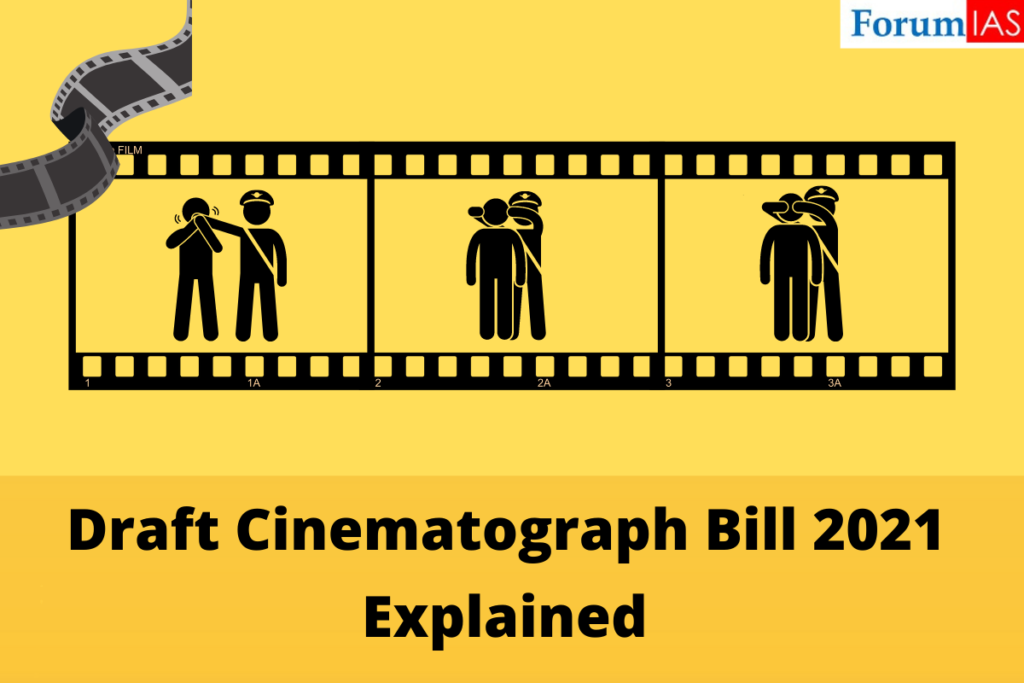Contents
Introduction
Recently, government released the Draft Cinematograph Bill 2021 which seeks to amend the Cinematograph Act of 1952.
- The Cinematograph Act is the sole legislation guiding the certification of films released in India for public exhibition. It regulates the Mumbai-headquartered CBFC, which is mandated with certifying every film released in Indian theatres.

Present draft comes shortly after the abolition of the Film Certificate Appellate Tribunal (a statutory body set up to hear appeals of film-makers against decisions of the CBFC). Earlier it was the last point of appeal for filmmakers against the certificate granted to their film.
Many sections from the film-making fraternity have expressed their concerns against the draft cinematograph bill. It is being criticized by filmmakers as a “super censor”. They are afraid that proposed changes would give the government overriding power over cinema and threaten freedom of expression in India.
From a UPSC perspective, it therefore becomes critical that we familiarize ourselves with issues surrounding this latest development.
Let us begin.
Key provisions of the bill
| Changes proposed | Existing provision |
Revision of certification: As per draft cinematograph bill, the Centre will have revisionary powers on account of violation of Section 5B(1) (principles for guidance in certifying films).
| The current Act, in Section 6, already equips the Centre to call for records of proceedings wrt a film’s certification but it is unable to use this power as,
|
Age-based certification: The draft cinematograph bill proposes to introduce age-based categorization and classification. proposes to divide the film categories into five age-based groups:
| Currently, films are certified into three categories —
|
| Provision against piracy: The draft proposes to add Section 6AA that will prohibit unauthorized recording. Penal provisions, including imprisonment and fine, have been proposed. | At present, there are no enabling provisions to check film piracy in the Cinematograph Act, 1952 |
| Eternal certificate: The draft proposes to certify films for perpetuity. | Currently a certificate issued by the CBFC is valid only for 10 years. |
Note: Section 5 B (1) of the Cinematograph Act, 1952, discourages certifying a film that is “against the
- interests of [the sovereignty and integrity of India] the security of the state
- friendly relations with foreign States
- public order
- Decency or morality, or involves defamation or contempt of court or is likely to incite the commission of any offence.
Rationale behind the changes
A change in censorship was the need of the hour because present system is stuck with age-old rules and regulations.
- Bifurcating the U and U/A ratings is indeed a welcome change. The age-based certification is good, as is in Europe and America.
- Provisions against piracy are much needed as the film industry is estimated to lose around ₹22,000 crore and around 60,000 jobs every year because of piracy.
- Govt has cited the “reasonable restrictions” placed by the constitution in Article 19 of the constitution to justify exercising its powers to act as a super-censor for films about which it receives complaints.
Criticism of the bill
- Role of CBFC: The draft cinematograph Bill must clearly define the role of the Central Board of Film Certification (CBFC) as a body that certifies film content for public exhibition, and not as a censoring body. The Bill in its current form overturns the sovereignty of the two bodies – CBFC and the Supreme Court
- Revisionary powers of the centre: The revisional powers that the Centre seeks in the draft law will not only see “State censorship” but also “mob censorship”.
- Encouraging vigilantism: The proposed Act will give a lot of power to vigilantism – instead of dealing with the problem. The plight of the independent filmmaker will be far more difficult. Any fringe group will be successful in getting films or OTT series banned.
- Undue impact on documentary-makers: The draft cinematograph Bill will fundamentally impact documentary makers more; the money to certify is charged basis a film’s length, the production cost of a 2-hour fiction film is hugely different from a 2-hour documentary, where a lot of radical work is happening.
- Compliance of anti-piracy provisions: Considering that film piracy in India rose by over 60% post-COVID, it is difficult to imagine how our already-stressed law enforcement agencies would be able to ensure the compliance of this provision.
Central Board of Film Certification (CBFC)
FCAT
|
Suggestions
- On CBFC: The government has to believe in the power of CBFC. There needs to be a guidance or grievance cell within the certification board.
- On piracy: The existing law penalizes piracy, there is no need to introduce further penal provisions”. Instead, sufficient exceptions on fair use, derivative work specific to films must be crafted. The offence must be made non-cognizable and bailable.
- Audio-Visual Media Council: Like the Press Council of India or Advertising Standards Council of India, there can be a Audio-Visual Media Council, a self-regulating body. It will “address and arbitrate on any public grievances or complaints about films, TV or OTT series, etc.
- FCAT should be reinstated: Reinstate the Film Certification Appellate Tribunal (FCAT) as it enables affordable and accessible remedies to filmmaker.
- Clear definition of public exhibition: Cinematograph Act must be amended to include a clear definition of ‘public’ exhibition and bring under its purview only commercial films with substantive capital investment and revenue models tied to theatrical exhibitions.
Conclusion
Preserving artistic freedom and reducing regulatory compliance are much-needed reforms for the film industry. The proposed changes in the draft amendment bill, however, do not seem to be easing either compliance issues or freedom of speech and expression through filmmaking in the country.
References:
Discover more from Free UPSC IAS Preparation Syllabus and Materials For Aspirants
Subscribe to get the latest posts sent to your email.







